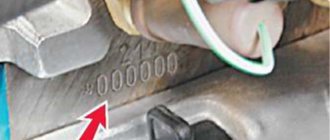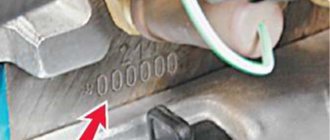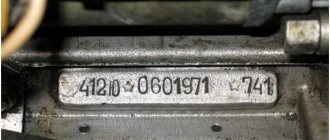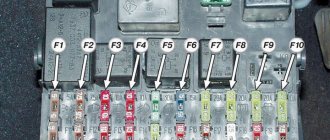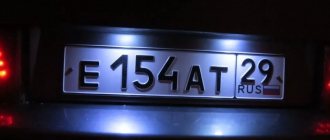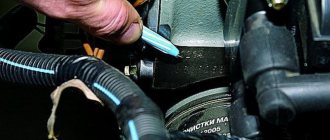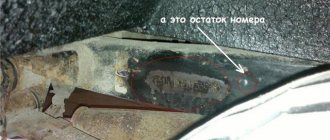To view the VAZ 2112 engine number, the user will need to perform a certain sequence of actions. This is due to the inconvenient location of the marking and its constant contamination. In most modifications of power plants, the coding is applied in one place, regardless of the number of valves and year of manufacture. There are separate versions where the index is moved to another location. The VIN number of the vehicle is highlighted separately. Marking is considered the most important and in demand when purchasing and registering a vehicle.
Where are the body and engine numbers on the VAZ 2110
It is necessary to know where the engine number is located on a VAZ 2110 vehicle. For example, when a car owner wants to buy a new engine, the engine number will help him choose exactly the model his car needs. When buying and selling a vehicle, you also need to know the engine number so as not to mislead the buyer. Many experienced car enthusiasts refuse to buy a car if there is no coding where it is usually located.
- Why do you need an engine number?
- Where is the engine identification number on the VAZ 2110
- Engine number on 16 valve
- Engine number on 8 valve
- Exceptions
- Decoding the number on the VAZ 2110
- What to do if the engine is dirty and the license plate is not visible
- What to do if the number is interrupted
- What to do if the number is unreadable
- Conclusion
Ways to clear a table
Number tables often become dirty and corroded. Do not use coarse sandpaper for cleaning. The exception is very fine sandpaper (2500 - 2000).
Gasoline is often used to clean the table. The printed information will become more contrasting over time. For convenience and speed of the procedure, a dish sponge is usually used. When cleaning, be careful to preserve the metal. When the engine, car body, or VIN tables are corroded, problems often arise and more time is required to carry out registration procedures.
Car body and engine numbers, VIN code - basic information identifying the vehicle. Number combinations must match the data in the documents.
This is interesting: How to understand what engine displacement is
Location of the engine number on the VAZ-2112
It happens that unknowing car enthusiasts are able to spend more than one hour under the hood of a car looking for the required identification number. The thing is that during operation, some of them can become covered with a thick layer of dirt, which makes them simply unsuitable for visual perception without prior preparation.
Layout of identification numbers under the hood
The photo below shows schematically where all the identification numbers are located under the hood.
The numbers indicate the location of the ID numbers.
- The car number marking ( VIN code ) is located here.
- Under the number two, all the installation passport data.
- The engine number is located under the thermostat housing, on the cylinder block . For convenience, you will have to move the air filter housing to the side.
Engine number here!
In order to check the engine number, you need to have a wire brush and WD-40 on hand in advance to make it easier to read dirty or corroded symbols.
VIN code
The vehicle identification number, in addition to being on the support cup under the hood, is also stamped in the niche for the spare wheel in the trunk . As a rule, they are always readable after a little cleaning with a rag.
Engine number on 16 valve
They changed the thermostat and checked the engine number!
The same cannot be said about the engine number, since its location is subject to constant exposure to road salt, reagents and high moisture. To make it easier to clean and read this number, you need to remove the air filter housing with the corrugation and you will see 2 rows of numbers on the block.
Clean numbers are much easier to read.
The top row indicates the engine model, and the bottom row directly indicates its number.
Engines VAZ 2112 hatchback 5 doors
In 1999, the manufacturer launched this line of machines. The successful version quickly gained popularity among buyers. Depending on the configuration and production date, the car was supplied to the market with different internal combustion engines. Carburetor and injection systems had a similar design and markings were applied in a specially designated area.
Petrol 1.5: 71, 76, 78, 91, 93 l with
On weak first-generation cars with an 8-valve cover, the manufacturer stamped markings near the thermostat. The inscription is written using the embossing method in metal, which guarantees its safety during long-term use.
The injector was placed essentially on similar blocks, which greatly limited the places where markings could be applied.
Petrol 1 6: 81 (VAZ-11183) and 89 (21124) l with
More modern modifications with 16 valves were installed on the VAZ 21124 version of the car, the engine here was distinguished by good throttle response and good dynamics. On internal combustion engines, an injector was mounted in stock; there were carburetor versions, but they were supplied to the market in minimal quantities.
Here, the engine serial number is also located on the top of the cylinder block on the thermostat side. To access it, the metal must be cleaned.
The marking itself consists of two lines.
- Indicates the powertrain model. This field is required for all VAZ vehicles.
- The bottom line indicates the serial number of the engine itself.
Petrol 1 8: 105 l s
To find the number marking on the fastest version of the engine, you will need to look under the thermostat or remove the air filter along with the device housing. This is where the code comes in.
Location
If the car has a number, then it is definitely registered. In order to figure out where the number is located, you need to open the hood. The rooms can be located in the following places:
- On both sides of the cylinder block.
- Below the hole for the engine oil level dipstick.
- The place where the gearbox and engine connect.
- On the air intake compartment.
- At the base of the corrector.
The engine number of the Lada Priora may be located in these places. You need to look carefully so as not to miss it, although recognizing it will not be difficult for an experienced driver.
What to do if the engine is dirty and the license plates are not visible
Those who do not take care of their car may encounter a problem when the markings on the engine are not visible. It is not necessary to immediately send the car to a car wash; it is enough to wash the device with your own hands. For small dirt deposits, you can wash it with a damp cloth soaked in detergent. If the unit is very dirty, you will need sandpaper. Although it’s better not to let it come to that. After washing, the number can be easily seen. If the dirt is not washed off, you cannot do without the help of a car wash.
Signs of inoperability of the idle speed sensor
Failures of the idle speed sensor 2112 relate to the electrical or mechanical parts of the device. Signs of malfunction:
- main symptoms: do not hold (“float”), intermittent, weak idle, the vehicle stalls at it, and also when driving in “neutral”, when the throttle valve is retracted, it stalls;
- It is impossible to start in a cold state without opening the damper (until the gas is pressed). On a cold unit, increased speeds are not observed at all; damping occurs after the gear is deactivated when the vehicle is moving;
The symptoms are identical to those for the TPS, but for the latter “CHECK ENGINE” is displayed; if this signal is observed, then it is the one that is broken. The location where the idle speed sensor is located must be distinguished from the location of the TPS.
How to check the engine number when purchasing a used car
To independently check the code, it is enough to study the identification table and the main documents issued for the vehicle.
This may be a registration certificate or PTS. Next you need to follow this procedure:
- inspect the motor number on its body;
- correlate the symbols on the body of the power unit with the symbols indicated in the vehicle registration certificate;
- if there is none, compare the information with the number indicated in the vehicle passport;
- If we are talking about American cars, the number on the engine may not appear, in which case it must be indicated in the PTS.
Separately, it is necessary to check whether the car is listed as stolen, and whether someone has tried to rename individual combinations of symbols. It is also important that all part numbers correspond to the designations specified in the relevant documentation.
Decoding the VIN 2112 code
The vehicle's VIN is located on the rear pillar in the trunk and under the hood. You can decipher the marking as follows.
- The first three characters indicate the manufacturer's index. The continent, the country of production and the plant itself are encrypted here.
- Next, six numbers are indicated indicating the model of the vehicle.
- Next is a Latin letter indicating the year of manufacture of the car.
- And the last part of the index is applied to determine the serial number of the body.
VAZ 2111 where is the body number on
Dear visitors of the “Cars” website! We will be very grateful for your comments on the video clip “VAZ 2111 where is the body number located on”; registration is not required for this. We also ask you to let us know if you have any problems playing the video.
Thanks for the answer. Now I’ll start putting the car in order. The Milky Way is a beautiful color.
12/13/2017 – 23:29 Antonio
Thanks for the review, special respect for the roll bars, otherwise everything is ok on the body, and now I’ll paint the ugly bars with a sponge too. What engine do you have? And how to raise your butt like yours?
28.11.2017 – 09:20 Alexey Pervomaisky
11/18/2017 – 14:48 Vladimir Ilyin
It’s the frameless ones that scratch, with their ends, where the plastic mask is located. And frame ones DO NOT scratch.
08.11.2017 – 00:24 Vladimir Ilyin
What is laquera?
10/18/2017 – 08:08 Vladimir Ilyin
The roof rails do not rust, they are aluminum. The paint is just peeling off. Aluminum falls apart from salt.
09/19/2017 – 05:24 Vladimir Ilyin
I pour the waste into the doors and thresholds. and nothing rusts. I do this in the fall, before winter. Can you tell me how to remove the plastic plate from the back door where the wiper sticks out?
Where is the VIN code and engine number of the Lada XRAY Topic author Dmitry
Where is the VIN code and engine number of the Lada XRAY? By law, each vehicle has an identification number (VIN code). This number is recorded in the vehicle passport (PTS). The identification number and other passport data are indicated on the summary plate, and the VIN code is also stamped on the body. Do you know where the VIN and engine number are located on XRAY? VIN code 1. The identification number (VIN code) is stamped on the floor under the front passenger seat on the right side. To inspect the room, a valve has been cut out of the carpet. The VIN code is also duplicated on the wall between the engine compartment and the engine. Depending on the configuration of the Lada XRAY, there may be a glove box under the passenger seat. In this case, to access the number, you must fully extend the movable part of the glove box by pulling the stops outward on both sides. 2. The marking (nameplate) is located on the right pillar, below, near the threshold. It indicates the model, car number, engine model, weight data, number for spare parts, design options, and configurations. Explanation: Name of the manufacturer OJSC AVTOVAZ (AVTOVAZ). Vehicle type approval number. It is given in full in the vehicle passport. Vehicle identification number VIN. Technically permissible maximum vehicle weight. Technically permissible maximum weight of a road train. Technically permissible maximum axle weight on the front axle. Technically permissible maximum axle weight on the rear axle. Vehicle designation. Engine designation. Number for spare parts. The number for spare parts corresponds to the serial number of the vehicle leaving the assembly line. When ordering spare parts, you must refer to the information contained on the identification plate. Market circulation sign. Let us recall that in accordance with the Decision of the Customs Union Commission dated June 15, 2022 No. 711, the model year is defined as a conditional year indicated by the manufacturer (usually following the actual year of manufacture of the vehicle). At JSC AVTOVAZ, the start of the model year is set on July 1 of the calendar year. Thus, from January 1 to June 30, the model year corresponds to the actual year of manufacture of the car, and from July 1 to December 31 corresponds to the one following the actual year of manufacture of the car. Model and engine number The VAZ engine model and number are stamped on the end of the cylinder block on the left next to the gearbox. On the Renault-Nissan HR16DE/H4M, the engine number is stamped on the cylinder block in the location shown in the figure: Let us remind you that instructions for operating and self-repairing the Lada XRAY can be found in this category or in the content. https://lada.online/car-description /reviews-tests/lada-xray-reviews-tests/1545-gde-nahoditsya-vin-kod-i-nomer-dvigatelya-u-lada-xray.html
The birth of the “gear”: how 16-valve VAZ engines survived to this day
VAZ cars could rarely boast of a particularly avant-garde design, although they tried to keep up with world trends. There were also some successes - for example, the VAZ-2101 received an overhead engine precisely as a result of the persistence and even tenacity of the Soviet side. And the car of the tenth family, born in a difficult period for the country, could already boast another technical innovation at the development level - a 16-valve engine, like the “hot” modifications of its European classmates. Today we recall the history of the development of the 2112 multi-valve engine, which became the basis for many other VAZ engines - including the most modern ones.
Trends of the times
And using the aggregate base and the G8 platform for the new model, Tolyatti understood that by the time mass production of the VAZ-2110 started, the “eighth” engine would inevitably become obsolete. After all, since the beginning of the eighties, environmental requirements in the world have become more stringent, and the liter capacity has constantly increased. The “charged” modifications of the Volkswagen Golf MKII and Opel Kadett E were practically twice as powerful as the basic versions (and the domestic Samara!), because their engines produced 130-140 “horses”! In addition, it became clear that the engine should not only be more powerful and environmentally friendly, but also more economical than its predecessor.
This could be achieved in several ways. Firstly, VAZ unconditionally accepted the transition to a more modern distributed injection , which theoretically made it possible to comply with any emissions cleanliness standards that were relevant at that time.
Secondly, it was necessary to increase the liter power in order to increase the number of “horses” under the hood, while remaining at the same working volume. After all, not in all countries of the world buyers welcomed “large” engines due to taxes. Yes, and NAMI strictly defined the “liter range” of Soviet technology - VAZs had to fit into the range of 1.2-1.6 liters.
At that time, two ways to “cheer up” had already been tested in practice in the world - installing a turbocharger or switching to a multi-valve cylinder head, where the number of intake and exhaust valves for each cylinder was doubled. Having weighed all the pros and cons, VAZ settled on the second option, since supercharging would require much greater costs and technological innovations, while the scheme with four valves per cylinder was otherwise (“lower”) not much different from eight-valve engine, and due to better filling of the cylinders, the power and torque indicators, all other things being equal, should have increased by 10-15%. This means that, coupled with the “injector”, it was actually possible to extract at least 90 hp from a one and a half liter engine.
Porsche again
Having no personal experience in designing such structures, the VAZ team turned to Porsche specialists “out of old memory.” In addition, the Soviet side needed help from the Germans in aerodynamically fine-tuning the body of the “tens” . The contract signed in 1987 included both aerodynamic work and the development of a 16-valve engine with multipoint injection. At the same time, the working volume remained the same - 1.5 liters.
However, VAZ did not sit idly by, shifting the work of developing a new engine onto the shoulders and hands of German “specialists”! Under the leadership of A. Simulman, a version of a multi-valve block head with cast spark plug wells was assembled - that is, without insert parts.
The design of the 16-valve cylinder head was born in close cooperation with foreign specialists and at the same time turned out to be completely original
The option proposed by Porsche was less technologically advanced - in particular, it required a very complex shaped head gasket, the production of a mold for which Soviet rubber goods specialists simply did not undertake. But the German company Elring, which VAZ specialists contacted, agreed to do everything in four months and 400,000 German marks! Both the first and second did not suit VAZ at all, so they had to. to develop the design using the efforts of the VAZ RTI STC, for which one month and 1,500 rubles were enough.
Prices for VAZ 2110 2111 2112 21124 engines on the secondary market (2020)
VAZ 2112 21124 16 valve engines, characteristics, maintenance
In 1997, the VAZ 2112 saw the light of day - it was the first serial AvtoVAZ 16-valve engine with two camshafts. Its volume was the usual 1.5 liters, it produced 92 horsepower with 130 Nm of torque. It was first installed on the Lada 2110, but the following year, 1998, the Lada 2112 started with it, and in 2000 it was also installed on the Lada 2113.
The VAZ 2112 engine was used by the concern for about 7 years. In 2004, a new generation VAZ engine began to be installed on the Lada 2110 - VAZ 21124. Which became 100 mm larger, slightly more powerful and more environmentally friendly (the main difference from its predecessor was an improved catalytic converter and new, individual ignition coils). Now Lada cars with a VAZ 21214 engine passed Euro 3 environmental standards (after modifications to the catalytic converter, and Euro 4). The VAZ 21214 engine lasted on the assembly line almost twice as long as its predecessor - from 2004 to 2013 and was installed on: Lada 2110, Lada 2112, Lada 2111, Lada Samara hatchback, Lada Samara Coupe.
Engine modifications
Due to the presence of free space inside the block and cylinder head, immediately after the creation of the basic version of the two-shaft 16-valve engine 2112, its versions began to appear:
- 21124 – boosting the internal combustion engine to 89 hp. With. due to the volume of 1.6 l;
- 21126 – modernization of the engine to a power of 98 hp. pp., volume 1.6 l;
- 21128 – maximum combustion chamber volumes 1.8 liters, power increase to 105 liters. With.
In these versions, the valves do not bend; overhauls are needed much less frequently. The first version was created solely to increase volume and comply with Euro-3 standards. Factory tuning was carried out by increasing the block height to 197.1 mm and increasing the piston stroke.
In the second version, the designers tried to ensure the maximum operational life of the units. For this purpose, special cylinder honing is used using the Federal Mogul method. Block 21126 is gray in color, and the number of classes of repair kits for pistons and cylinder liners has been reduced to three in increments of 0.01 mm.
